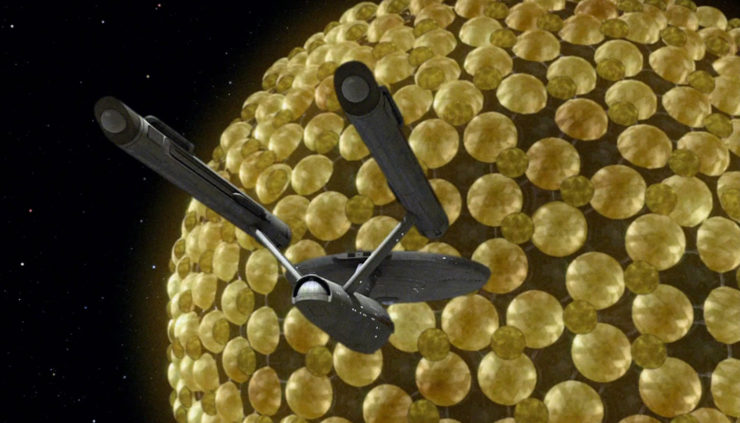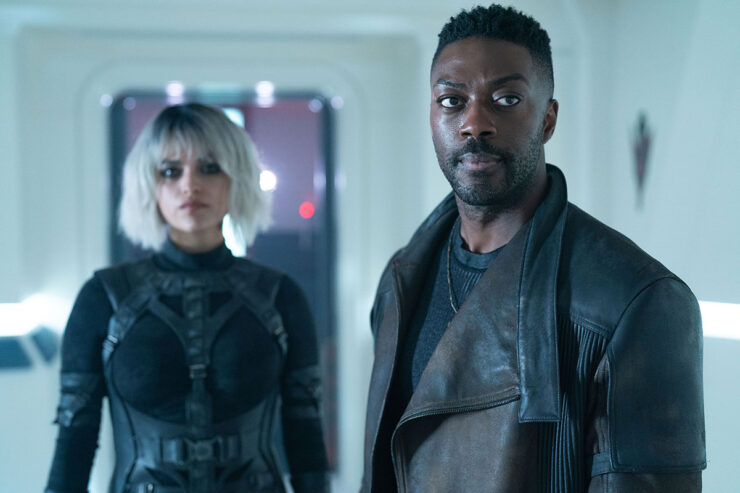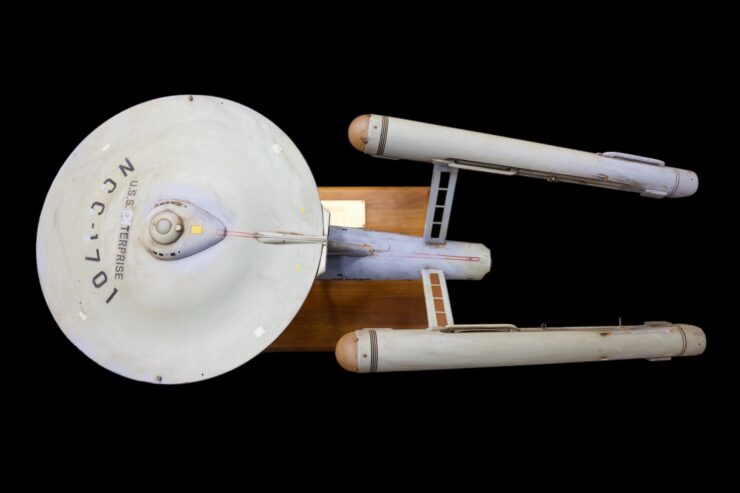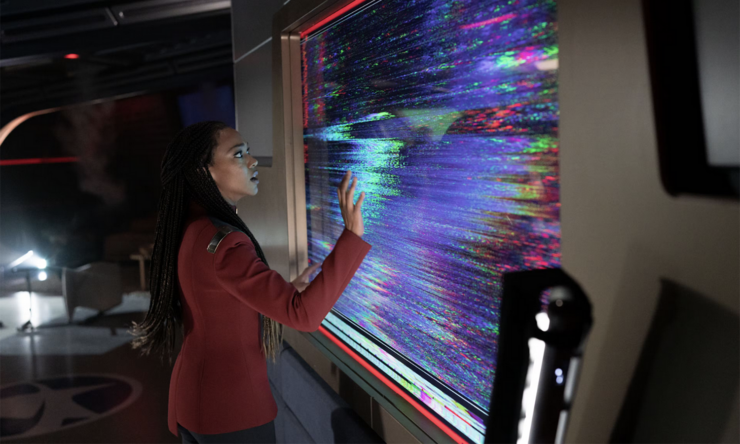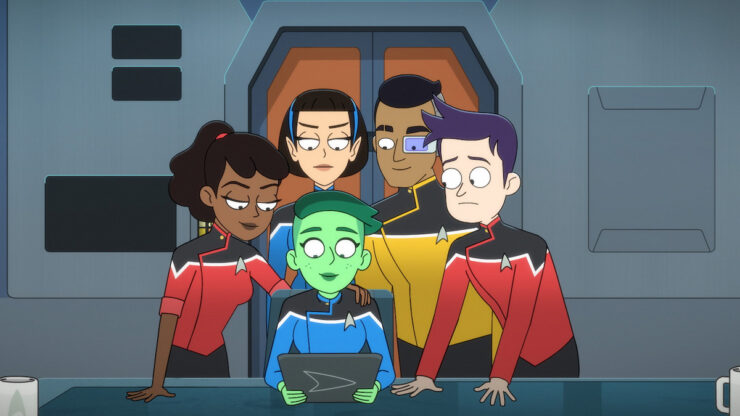1. The Federation is most interesting when it has an ideological foil
The original Star Trek pitted Captain Kirk against fake gods, rogue Starfleet officers, and sadistic computers, but the show was often concerned with a Cold War-style rivalry between the Federation and two warlike powers, the Klingons and the Romulans. The Federation seldom needed to demonstrate its own peace-loving, liberal values—it just needed to appear in contrast with civilizations that were bent on domination and conquest. Similarly, Star Trek: The Next Generation was never so vital as when its ethos of individualism and self-improvement was in contrast with the collectivist, anti-individualist Borg. (An earlier attempt to give the TNG-era Federation an ideological foil, the hyper-capitalist Ferengi, basically fizzled.)
In Star Trek: Deep Space Nine, the Federation’s light touch when it came to matters of religion and self-determination (vis-a-vis the Bajorans) stood in contrast to the coercive theocracy of the Dominion. People often try to find a “bad guy” in Trek, like Khan for example—but these shows and movies usually work best when there’s an ideological struggle against another civilization or organization. Count me among those who really enjoyed the struggle against the Emerald Chain in Star Trek: Discovery, and was sad to see them dispatched so easily.
2. If Phase II had made it to air, that might have been the end of Trek
Back in the 1970s, Gene Roddenberry was trying to launch new TV shows with no success, but he was also trying to bring back Star Trek. First, there was the (underrated) Animated Series, and then the lavish and majestic Star Trek: The Motion Picture. But in between those two efforts, there was a failed venture called Star Trek: Phase II. This would have been essentially a continuation of the original series, except without Leonard Nimoy’s Spock. Some of the Phase II scripts were recycled for use in TNG‘s second season during the 1987 writers strike, and a lot of the show’s concepts found their way into both TMP and TNG.
My guess is that if Phase II had made it to air in 1977 or thereabouts, it would have felt a lot like the first two seasons of TNG, with all of their glaring faults—except that it also would’ve felt like an attempt to resurrect the Original Series, only worse. “TOS without Spock” does not sound like a winning formula to me. Especially coming on the heels of the original Star Wars, Phase II might have felt a little clunky by comparison. Moving the TOS cast to movies and then eventually creating a new show with a different cast, on the other hand, made Trek feel fresh and interesting again, and helped to ensure the longevity of the series by showing that it could survive the departure of literally all of its stars.
3. The contradiction at the heart of Trek gives it a lot of its power
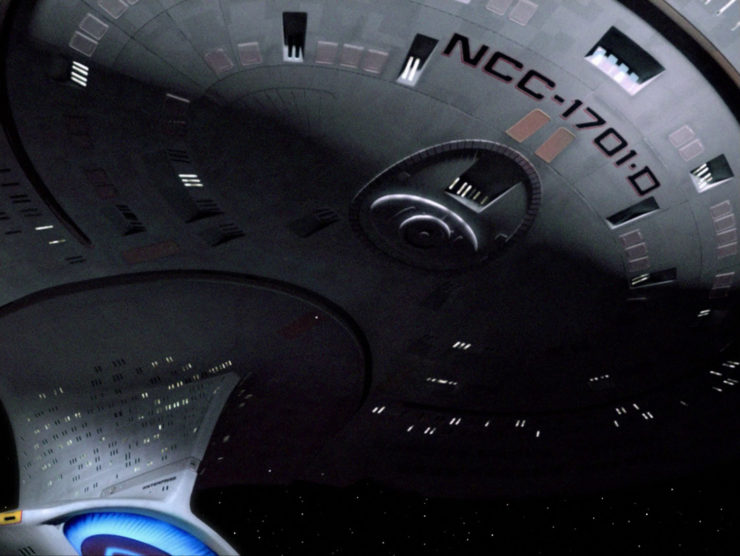
Starfleet is simultaneously a militaristic organization loosely modeled on the U.S. Navy, and also a peaceful scientific institution whose members are encouraged to think for themselves and to take up artistic hobbies—as long as they only perform Shakespeare plays or music that someone from the mid-twentieth century would immediately recognize. Some of the most memorable scenes in TNG involve crewmembers who’ve disobeyed orders and get dressed down by Picard or some other officer. That moment when someone reaches the limits of Starfleet tolerance, and discovers that individualism and kindness aren’t always the order of the day, is always super fascinating. This dichotomy also powers a lot of the best Trek dilemmas, which boil down to whether to respond to some new, dangerous phenomenon with curiosity or aggression.
4. We need a Saavik TV show or movie
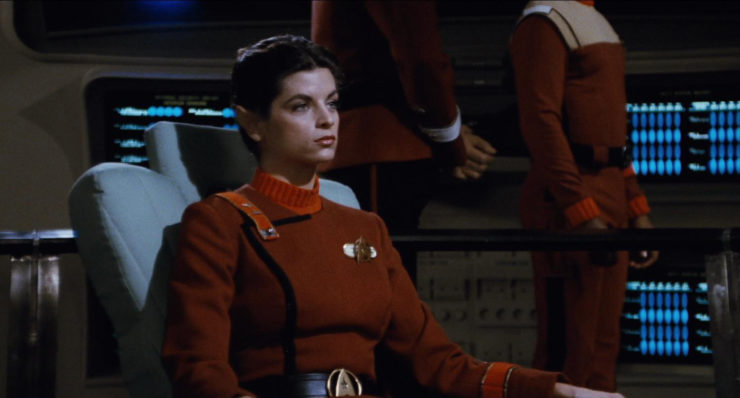
I understand why Jean-Luc Picard became the first Star Trek character to headline a TV series—because after all, Patrick Stewart is a beloved figure, even to extremely casual Trek fans. But when I think about Star Trek characters who both need and deserve to be explored further in long-form storytelling, my mind goes to Saavik. Even in a film as overstuffed with goodness as Star Trek II: the Wrath of Khan, Saavik stands out as one of the most interesting characters: an ambitious young Vulcan who looks up to Spock while also striving to embody the Starfleet values that Kirk often overlooks (because they come in the form of regulations.) Later, there are hints that she’s half-Romulan. The treatment of Saavik after Wrath of Khan is one of the worst travesties in Star Trek history: first, she helps the rejuvenated but rapidly-aging Spock through a slew of pon-farrs, then she’s tossed aside. Saavik is basically transformed into one of many plot devices in a clunky movie that only exists to bring Leonard Nimoy back to the franchise he’d been so eager to escape. Saavik was supposed to return in Star Trek VI as a traitor to the Federation, but she was replaced by Valeris. I have so many questions about this character: Does she have Spock’s baby? Why didn’t she go with Kirk and the others in Star Trek IV? How does she approach her return to the Federation after everything she went through? Justice for Saavik!
5. Discovery is the most hopeful Trek of the past decade
There’s been a meme going around that Star Trek: Strange New Worlds is better than Discovery, and I already wrote about why we can actually love them both, instead of pitting two great shows against each other. But one of the reasons people dunk on Discovery is because they feel like it’s not hopeful enough, and I strongly disagree. Sure, Discovery‘s first season overdosed on “gritty war drama.” But starting with season three, when Discovery really got good, it’s been a show all about resilience and rebuilding. Yes, a thousand years from now, the Federation has fallen—but that’s not the end of the story: Michael Burnham and her crew work tirelessly to restore the Federation without compromising its values, and they show that even in the dark times, you can persevere. It’s easy to be upbeat when you’ve got magical technology and unlimited warp drive. It’s a lot harder when all the dilithium is gone and most of your ships have blown up. Discovery doesn’t shy away from showing the enormity of the challenge, but also shows these characters rising to face it—while keeping their scientific curiosity and their respect for other forms of life, including the very unfamiliar aliens they meet at the edge of the galaxy in season four. I often think a pivotal scene in Discovery is the one where Admiral Vance is negotiating with the leader of the Emerald Chain, and he chooses not to take the expedient path, even though sticking to his principles may end up costing the Federation everything. That, to me, is the essence of Star Trek.
6. Discovery ought to be the present of the Star Trek universe
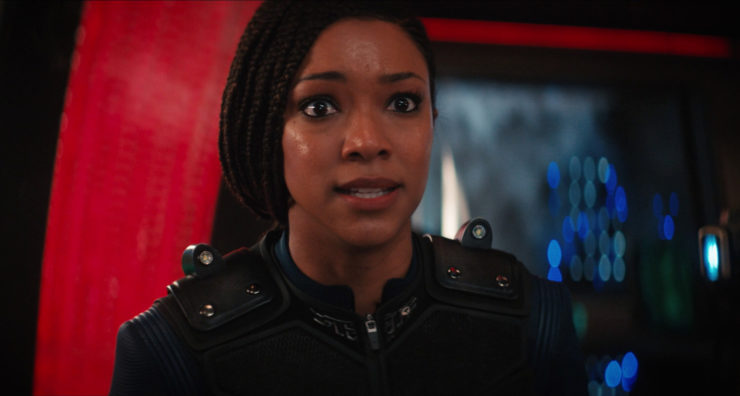
For a period of four or five years, we were getting Star Trek movies starring the original TOS crew, while TNG was also on the air. Star Trek VI leaned into this, with a storyline that showed us how the more constructive relationship with the Klingons in the TNG era had come to pass. At a certain point, it was obvious that the TOS movies were now taking place in the past of Star Trek, while TNG was the present. Star Trek is now missing this feeling of history moving forward, with events in the past contributing to progress in the here and now. Given that Discovery now takes place much later than every other Star Trek show, the best way to get back that feeling would be to make it clear that events in Strange New Worlds, Picard, Lower Decks, etc., are all moving us towards the future we see in Discovery. Not just because I like Discovery a whole lot, but because I like to see Star Trek showing how we are always moving towards a better future.
7. Star Trek needs to get back to being about what it means to be human in a messed-up cosmos
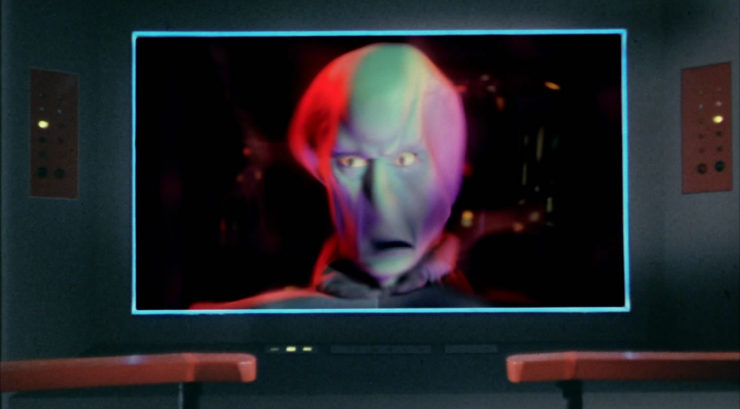
Gene Roddenberry brought a strong humanist ethos to Star Trek. During his lifetime, the series was always about humanity’s capacity for self-improvement. And it’s important to remember that Star Trek takes place in a universe that is completely ridiculous. There are space gods with terrible fashion sense everywhere you go, and giant planet-destroying super-carrots, and huge incomprehensible mysteries—and against all of this are a group of tiny fragile humans, who muddle through using their wits and their intellect and an ability to spew endless bullshit. TOS, TNG, and to some extent other older Trek series, always include at least one non-human character, like Spock, who has an ambivalent relationship with humanity but appears unable to escape a certain fascination with our species. I can’t think of a character in the newer Trek shows who occupies that Spock role, except for maybe Spock himself, in Strange New Worlds. (Maybe Saru a little bit, but not really.)
I would love to see Trek return to asking whether humans really can do better, whether we’re capable of dealing with a universe that is so huge and incomprehensible, and whether anybody would ever really want to be like us. After all, look around you—we are currently caught up in huge incomprehensible events, and at the mercy of near-omnipotent people with terrible fashion sense. Now is exactly the time when I need some speechifying about what it means to be human, and what humans can become if we work at it.
This article was originally published at Happy Dancing, Charlie Jane Anders’ newsletter, available on Buttondown.
All screencaps above via TrekCore.com.
Buy the Book
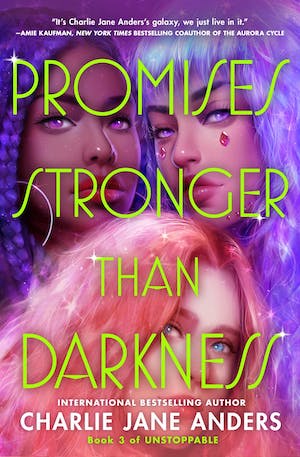

Promises Stronger Than Darkness
Charlie Jane Anders is the author of the young-adult trilogy Victories Greater Than Death, Dreams Bigger Than Heartbreak, and Promises Stronger Than Darkness(which publishes on April 11, 2023), along with the short story collection Even Greater Mistakes. She’s also the author of Never Say You Can’t Survive (August 2021), a book about how to use creative writing to get through hard times. Her other books include The City in the Middle of the Night and All the Birds in the Sky. Her fiction and journalism have appeared in The New York Times, the Washington Post, Slate, McSweeney’s, Mother Jones, the Boston Review, Tor.com, Tin House, Teen Vogue, Conjunctions, Wired Magazine, and other places. Her TED Talk, “Go Ahead, Dream About the Future” got 700,000 views in its first week. With Annalee Newitz, she co-hosts the podcast Our Opinions Are Correct.










